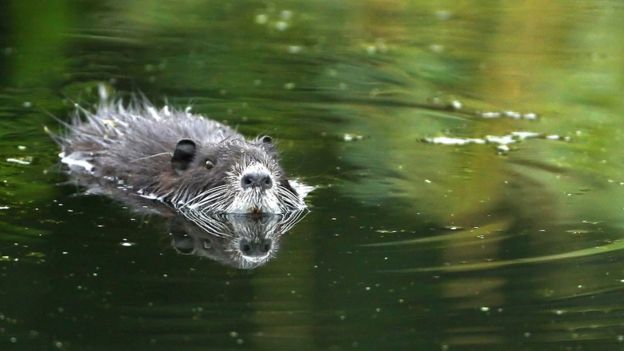This has been a fairly auspicious week for beavers. Their benefits have been touted in the CA wine country, Illinois and now the UK. I hope all this good press doesn’t go to their heads. This fine offering is from science writer Roger Harrabin
Beaver return ‘benefits environment’
Beavers should be re-introduced to England to improve water supplies, prevent floods and tackle soil loss, a researcher says. New results from a trial in Devon show muddy water entering a beaver wetland is three times cleaner when it leaves.
The farmers’ union, NFU, warns that beavers brought back to Scotland have damaged fields and forestry. But Prof Richard Brazier, who runs the Devon trial, says farmers should thank beavers for cleaning up farm pollution.
Unpublished preliminary results from his tests for Exeter University showed that a pair of beavers introduced six years ago have created 13 ponds on 183m of a stream. The ponds trapped a total of 16 tonnes of carbon and one tonne of nitrogen – a fertiliser that in large quantities harms water supplies.
 During heavy rains, water monitored entering the site has been thick with run-off soil from farm fields – but the soil and fertilisers have been filtered out of the water by the network of dams.
During heavy rains, water monitored entering the site has been thick with run-off soil from farm fields – but the soil and fertilisers have been filtered out of the water by the network of dams.
“We see quite a lot of soil erosion from agricultural land round here (near Okehampton),” he told BBC News.
“Our trial has shown that the beavers are able to dam our streams in a way that keeps soil in the headwaters of our catchment so it doesn’t clog up rivers downstream and pollute our drinking and bathing waters. “Farmers should be happy that beavers are solving some of the problems that intensive farming creates.
“If we bring beavers back it’s just one tool we need to solve Britain’s crisis of soil loss and diffuse agricultural pollution of waterways, but it’s a useful tool.”
16 tons of carbon and 1 ton of nitrogen! That’s pretty impressive, even if they do spell it with an E. It refers to the metric ton, which is actually bigger than ours. So that small trial beaver population is making a HUGE difference. It’s startling that they’re maintaining 13 dams, because that’s so much work. I assume the idea is diffusing the water force over many dams makes the threat to any single one less, and the repairs needed smaller. I wonder what our beavers would have done if they were given the run of the place and endless supplies of trees. The most we ever had was 5, but I’m sure if they had been allowed to flood out escobar street they might have advanced.
Of course it’s a ‘both sides’ article so it interviews Dr. Negative Nellie from pain in the arse university, too.
Another soil expert, Professor Jane Rickson from Cranfield University, is yet to be convinced about the multiple benefits of these hard-working, continental night workers.
She told BBC News any beaver dams must be “leaky” – so they don’t hold back large volumes of water that might be released all at once in an extreme flood event.
She agreed that in some places the UK was suffering a crisis of soil loss, and said new policies were urgently needed.
But, she said, beavers might reduce the river channel, increasing the risk of flooding – or, in areas of poor cover, they might remove vegetation, expose soil and thus increase erosion.
A spokesperson from the Environment Agency was also lukewarm about beavers, saying: “Natural and hard flood defences both have an important role in keeping communities safe – though introducing beavers does not form part of our approach.”
The authorities are wary of mass beaver re-colonisation of England, following the controversy over beaver re-introduction in Scotland – where they are now protected species after a trial by the Scottish government.
In Tayside, some land owners have angrily complained about beaver damage to commercial forests and fields, and others objected to the £2m cost of the trial.
Yes yes, beaver dams are leaky. It’s one of their great benefits since the water that passes through them comes out cleaner on the other side. And you are doing a very good job as the “might” patrol; thinking of all the harm that beavers might cause. There’s a really fun video on the site that I don’t think I can share here, although I’m still trying. Go watch it because it’s that good and short.

And of course a photo of a nutria/coypu instead of a beaver because hey, why the hell not?
Meanwhile we received word that we got our grants from both Kiwanis and the Martinez Community Foundation yesterday, so thank you both so very much and we are looking prepared for beaver festival 10. Planning meeting tomorrow and all is right on schedule!





 In the first half of November, Beaver Patrol member Jos Bakker ran into and confronted the man when he was in the process of destroying a dam. The man doesn’t appear to have come back after that, but the damage was already done, Caldwell said.
In the first half of November, Beaver Patrol member Jos Bakker ran into and confronted the man when he was in the process of destroying a dam. The man doesn’t appear to have come back after that, but the damage was already done, Caldwell said.







































